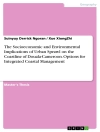Palaeolimnology is one of the most rapidly developing fields of limnology. The primary objective of this volume is to present new palaeolimnological findings from eastern and central Europe. Although this area has sometimes received less attention than other areas of Europe, the lakes and mires, coupled with the variability in landscape and the local differences in climate, provide unique opportunity for studying palaeolimnology. The volume starts with a review on late Quaternary records form the Carpathian region, followed by new results on the history of a crater lake, Lake Saint Ana, glacial lakes in the Tatra Mountains and Lake Bled in Slovenia. In addition, the various papers provide new insights on the development of lakes and bogs during the late glacial and Holocene, using a wide range of palaeolimnological proxies, including diatoms, pollen, macrofossils, pigments, cladoceran remains, chironomids, chaoborids, stable isotopes and geochemistry. The motivation for collecting recent knowledge derives from the recognition of the importance, and applicability of palaeolimnological tools to help in defining ‘reference conditions’ as designated within the Water Framework Directives and estimating influence of global climate change on surface waters.
Table of Content
Foreword: A virtual congress on palaeolimnology—palaeolimnological proxies as tools for environmental reconstruction in fresh water.- Review of dated Late Quaternary palaeolimnological records in the Carpathian Region, east-central Europe.- Palaeolimnology of the last crater lake in the Eastern Carpathian Mountains: a multiproxy study of Holocene hydrological changes.- Subfossil diatoms and chironomids along an altitudinal gradient in the High Tatra Mountain lakes: a multi-proxy record of past environmental trends.- Palaeoclimatic signals and anthropogenic disturbances from the peatbog at Nagybárkány (North Hungary).- Late Pleistocene-early Holocene transition recorded in the sediments of a former shallow lake in the Czech Republic.- A multi-proxy Late-glacial palaeoenvironmental record from Lake Bled, Slovenia.- Lake-peat bog transformation recorded in the sediments of the Stare Biele mire (Northeastern Poland).- Diatoms as a proxy in reconstructing the Holocene environmental changes in the south-western Baltic Sea: the lower Rega River Valley sedimentary record.- Reconstruction of human influence during the last two centuries on two small oxbow lakes near Warsaw (Poland).- Larval chaoborid mandibles in surface sediments of small shallow lakes in Finland: implications for palaeolimnology.- Holocene climate on the Modoc Plateau, northern California, USA: the view from Medicine Lake.- Multiproxy study of anthropogenic and climatic changes in the last two millennia from a small mire in central Poland.- Sedimentary multiproxy response to hydroclimatic variability in Lagunillo del Tejo (Spain).- Basin elevation and salinity changes: late Holocene development of two freshwater lakes at the Karelian White Sea coast, northwest Russia as reflected in their sediments.- Anapproach to the recent environmental history of Pilica Piaski spring (southern Poland) using diatoms.- Diatom-inferred trophic history of IJsselmeer (The Netherlands).- Palaeolimnology of Lake Hess (Patagonia, Argentina): multi-proxy analyses of short sediment cores.- A multi-proxy paleolimnological reconstruction of trophic state reference conditions for stratified carbonate-rich lakes in northern Germany.












